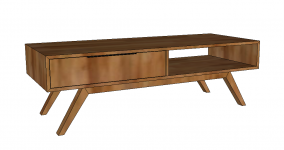I've used OSMO Polyx on several pieces and you definitely don't want to over apply it. It needs to be completely absorbed into the wood and not just sit on top of it.
I rub the white 3M pad fairly vigorously to heat it up to aid absorption into the wood pores. This can get fairly tiring on a large piece.
Here is an excerpt from an email I recently sent to a friend of mine in Oregon who admired some Texas Mesquite I had finished with OSMO Polyx -
There is some conflicting information on the best application method (including from the company itself) so I have included the approach I chose after viewing all the available videos and speaking with the technical support guy at Osmo USA as well as the distributor here in the States. Remember that this was developed and is primarily used as a hardwood floor finish in Europe so the techniques for furniture are the result of different people's experimentation.
My method is as follows:
1. Sand to 150 or 180 but no more as it closes the grain and it can't absorb the oil.
2. Stir for three to five minutes to insure good suspension of the wax.
3. Apply one thin coat of Osmo Polyx using a white 3M pad & really rub it in working on a small section at a time.
4. Wipe off any excess with the grain
5. Allow to dry overnight
6. Stir at least 1 minute to ensure good suspension of the wax.
7. Apply a second thin coat of Osmo Polyx using a white 3M pad & really rub it in working on a small section at a time.
8. Wipe off any excess with the grain
9. Allow to dry overnight
10. That's it, you're done! Don't apply a third coat (although I may experiment with Peter Parfitt's "Gloss" technique featured in his third video below)
Here are the videos ranked in my personal order of value:
Wood Work Web - Phil Makin Learning to Use Osmo Part 1
Wood Work Web - Phil Makin Learning to Use Osmo Part 2
Peter Parfitt (Festool UK Reviewer) Review & Wine Test
Peter Parfitt (Festool UK Reviewer) Application Methods
Peter Parfitt (Festool UK Reviewer) Walnut "Gloss" Finish
Osmo Double Blade Scraper
I also found this article helpful.
http://blog.lostartpress.com/2014/04/08/my-favorite-finish-for-now/
Here is a PDF from Phil Makin (First 2 Videos) with a different approach. I think this was done earlier as it is dated 2010 and the videos were made in 2012 so the his best practices may have evolved over time.
http://www.raincoastalternatives.com/index.php/download_file/47/
It looks very similar to OSMO's official instructions for using it on furniture but like I said their own technical support guy recommended less sanding and lighter application.
http://www.osmona.com/pdfs/install/osmo_polyx_furniture_application.pdf
I bought the product from Reid at World Class Supply in the 0.75ml size as it really goes a long ways. His number is 302-737-1441. He's a super nice guy with a wealth of information and is well worth talking to.
http://worldclasssupply.com/store/OSMO-Polyx-Hard-Wax-Oil-the-original-hardwax-oil-in-.125-.75-2.5-or-10-Liter-Sizes.html
Be sure to read his excellent responses to a thread about OSMO I started on Festool Owners Group. Reid's username is "italkgreen".
http://festoolownersgroup.com/finishing/osmo-polyx-oil-finish-anyone-use-it/new/?topicseen#new
Here is the OSMO's North American website.
http://www.osmona.com/interior/Original_polyx.shtml and the phone number for their technical support 800-515-4168. The one big thing they recommend against is using this product on certain oily woods whose hardness and close grain make them troublesome with any oil finish. These are listed on the last page of this document.
http://www.osmona.com/pdfs/install/osmo_polyx_application_instructions.pdf
I hope all this information isn't too overwhelming! I tend to research stuff to death because I don't want to mess it up when I finally try it.


